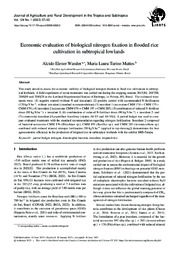Publicações
Economic evaluation of biological nitrogen fixation in flooded rice cultivation in subtropical lowlands.
Autoria: WANDER, A. E.; MATTOS, M. L. T.
Resumo: This study aimed to assess the economic viability of biological nitrogen fixation in flood rice cultivation in subtropical lowlands. A field experiment of seven treatments was carried out during the cropping seasons 2015/16, 2017/18, 2018/19 and 2019/20 at the Lowland Experimental Station of Embrapa, in Pelotas, RS, Brazil. The evaluated treatments were: (1) negative control (without N and inoculant); (2) positive control with recommended N-fertilisation (120 kg N ha?1, without inoculant) (standard recommendation); (3) inoculant 1 (accessions CMM 174 + CMM 175 + CMM 179); (4) inoculant 2 (accessions CMM 176 + CMM 197 + CMM 205); (5) combination of reduced N-fertiliser doses (90 kg N ha?1) + inoculant 1; (6) combination of reduced N-fertiliser doses (90 kg N ha?1) + inoculant 2; and (7) commercial inoculant [Azospirillum brasilense (strains Ab-V5 and Ab-V6)]. A partial budget was used to compare evaluated treatments with the standard recommendation regarding nitrogen fertilisation. Inoculant 2 composed of bacterial accessions CMM 176 (Rhizobium sp.), CMM 197 (Bacillus sp.) and CMM 205 (Aeromicrobium sp.) combined with reduced mineral nitrogen fertilisation [90 kg N ha?1 (applied in top dressing)] demonstrates the best agroeconomic efficiency in the production of irrigated rice in subtropical lowlands with the cultivar BRS Pampa.
Ano de publicação: 2023
Tipo de publicação: Artigo de periódico
Unidade: Embrapa Arroz e Feijão

